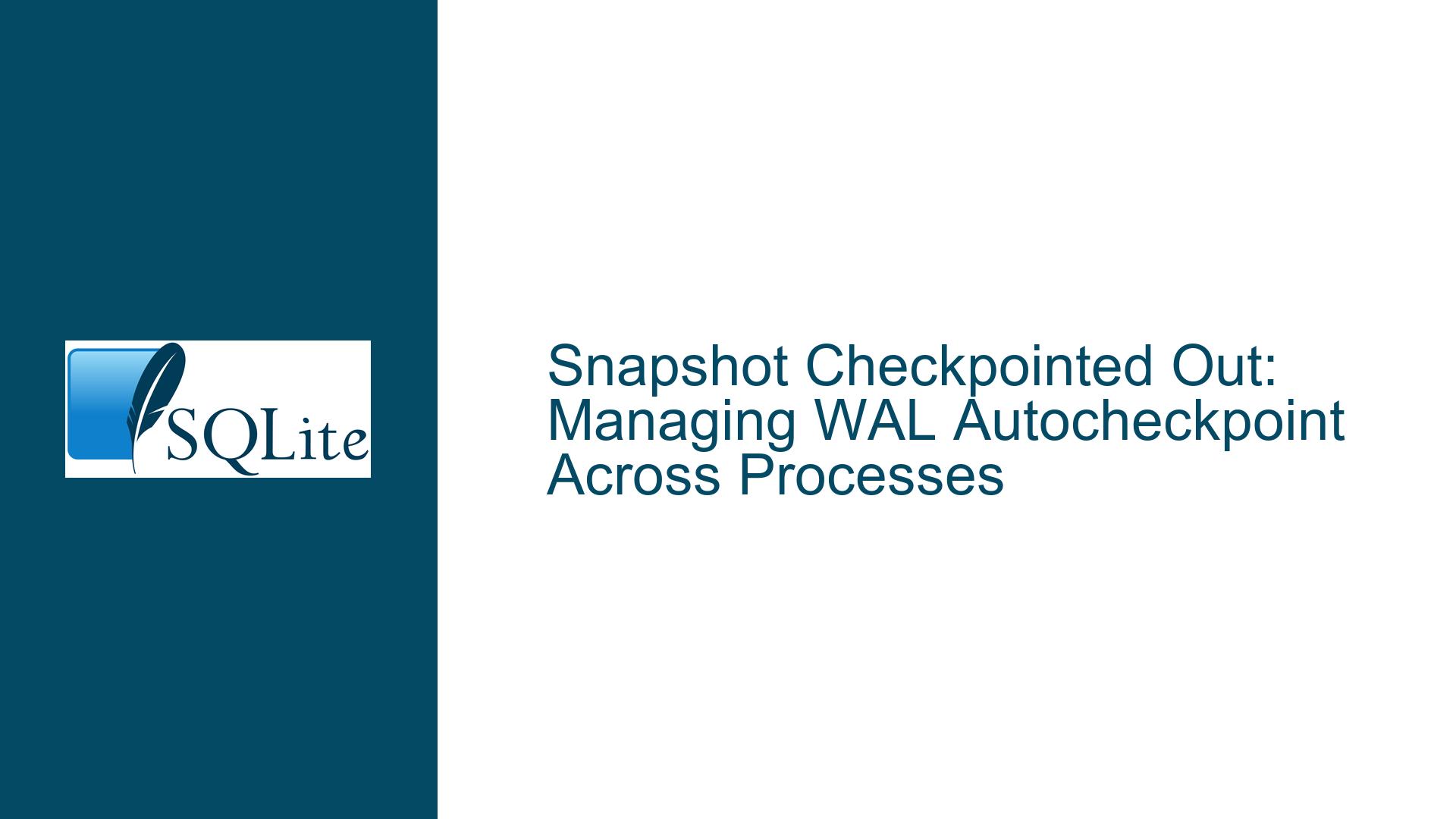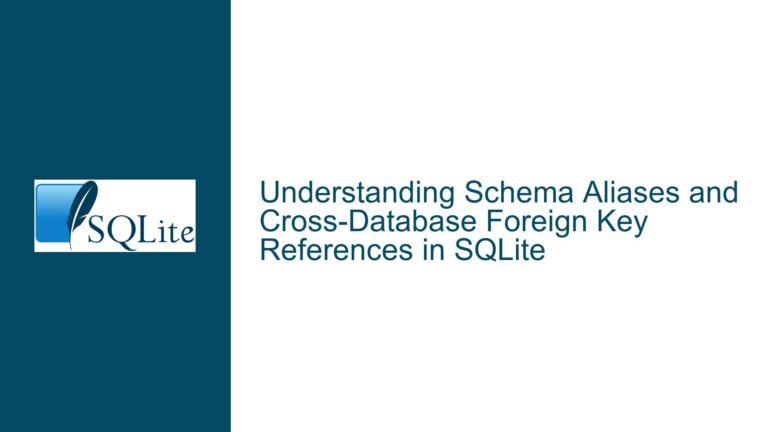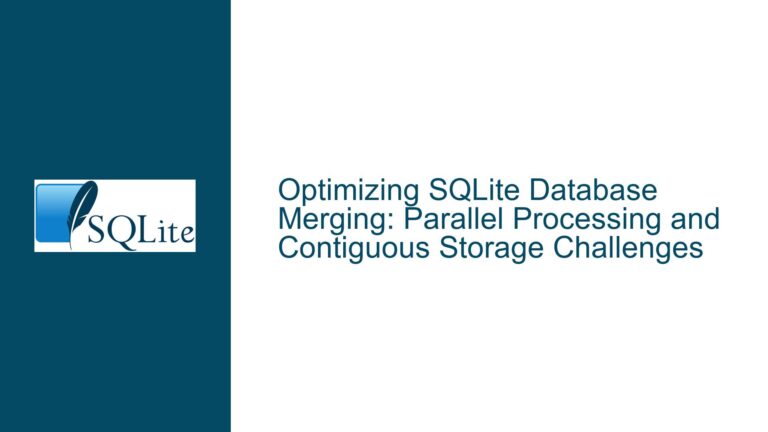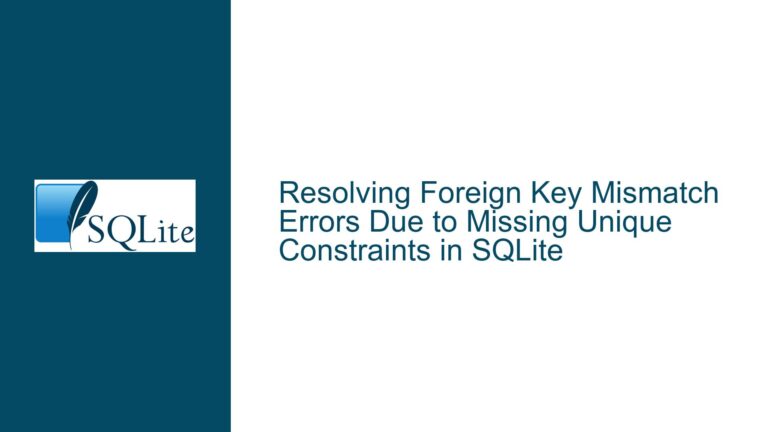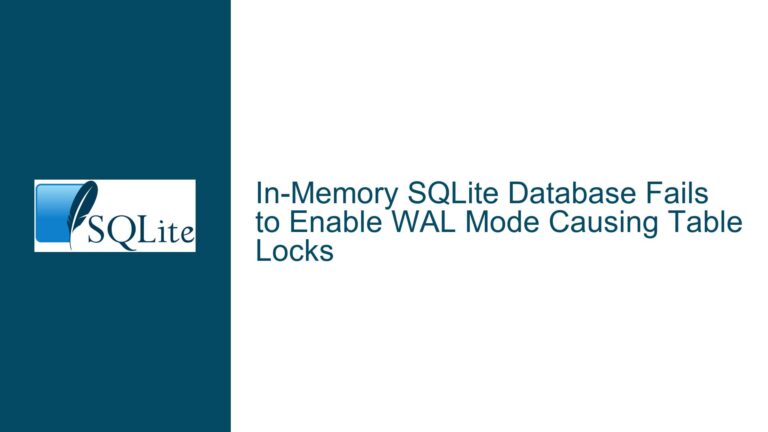Snapshot Checkpointed Out: Managing WAL Autocheckpoint Across Processes
Snapshot Checkpointed Out: Managing WAL Autocheckpoint Across Processes
Process B Snapshot Fails Due to Premature WAL Checkpointing by Process A
Issue Overview
This guide addresses a scenario where two processes (A and B) interact with a shared SQLite database in Write-Ahead Logging (WAL) mode. Process A continuously writes data to the database, while Process B attempts to create and reuse a consistent snapshot of the database state. The failure occurs when Process B tries to reopen its snapshot using snapshot_open, resulting in SQLITE_ERROR_SNAPSHOT. The root cause is that the snapshot created by Process B is checkpointed out of the WAL file by Process A before Process B can reuse it.
The critical observations are:
- Process A operates with WAL autocheckpointing enabled.
- Process B disables autocheckpointing via
PRAGMA wal_autocheckpoint=0and creates a snapshot. - Despite Process B’s configuration, Process A continues to perform automatic checkpoints, invalidating the snapshot.
The disconnect arises from the fact that wal_autocheckpoint is a connection-specific setting. Disabling it in Process B does not affect Process A’s behavior. Checkpointing in SQLite is driven by the WAL file size and active read transactions. If Process A’s autocheckpointing remains enabled, it may automatically trigger checkpoints that prune the WAL file, removing frames required by Process B’s snapshot.
The broader challenge involves coordinating checkpoint behavior across multiple processes sharing the same database. SQLite’s architecture treats each process as an independent entity with no built-in inter-process communication for configuration settings like wal_autocheckpoint. This necessitates explicit synchronization mechanisms to preserve snapshots across processes.
Misconfigured WAL Autocheckpoint Settings and Inter-Process Checkpoint Contention
Possible Causes
Connection-Specific
wal_autocheckpointConfiguration
ThePRAGMA wal_autocheckpointsetting is scoped to individual database connections, not the database file or global state. Disabling autocheckpointing in Process B has no effect on Process A’s connection. Process A continues to checkpoint the WAL file based on its own configuration, leading to premature removal of WAL frames required by Process B’s snapshot.Lack of Active Read Transactions Blocking Checkpoints
Checkpointing in WAL mode is blocked only if there are active read transactions holding references to older WAL frames. If Process B creates a snapshot but does not maintain an active read transaction, Process A’s checkpoints may proceed unimpeded. Thesnapshot_getAPI does not inherently block checkpoints; it merely captures the current WAL state. Without an open read transaction, the WAL file is subject to truncation.Insufficient Coordination Between Processes
SQLite does not enforce cross-process synchronization for configuration changes or checkpointing. Process A operates independently, unaware of Process B’s snapshot requirements. This lack of coordination allows Process A to checkpoint the WAL file even if Process B relies on its contents.Misinterpretation of Checkpoint Blocking Rules
The WAL documentation states that checkpoints are blocked by active readers. However, this applies only to readers in the same process or those holding shared locks that prevent WAL reset. Process B’s snapshot alone does not create such a lock unless accompanied by an explicit read transaction.Deferred Transaction Lock Acquisition
ABEGIN DEFERREDtransaction does not immediately acquire a read lock. Locks are acquired lazily upon the first database read operation. If Process B starts a deferred transaction but does not execute aSELECT, it fails to block checkpoints, allowing Process A to truncate the WAL.
Enforcing Cross-Process Checkpoint Blocking via Read Transactions
Troubleshooting Steps, Solutions & Fixes
Step 1: Establish a Persistent Read Transaction in Process B
To block checkpoints, Process B must maintain an active read transaction that references the snapshot’s WAL state. This requires:
- Opening a dedicated database connection in Process B before creating the snapshot.
- Starting an explicit read transaction (
BEGIN IMMEDIATEorBEGIN EXCLUSIVEis unnecessary;BEGIN DEFERREDsuffices). - Executing a
SELECTstatement to force acquisition of a read lock. For example:BEGIN; SELECT COUNT(*) FROM sqlite_schema; -- Forces read lock acquisition
This read transaction must remain open for the duration of the snapshot’s required validity.
Step 2: Disable Autocheckpointing in All Processes
While wal_autocheckpoint is connection-specific, disabling it in all processes ensures no automatic checkpoints are triggered. For Process A:
PRAGMA wal_autocheckpoint=0;
For Process B:
PRAGMA wal_autocheckpoint=0;
Manual checkpointing can then be performed at controlled intervals using PRAGMA wal_checkpoint.
Step 3: Use snapshot_get After Read Transaction Initiation
Process B should create the snapshot only after the read transaction is active. The sequence becomes:
- Disable autocheckpointing in Process B.
- Start a read transaction with a
SELECT. - Create the snapshot using
sqlite3_snapshot_get(). - Use
sqlite3_snapshot_open()in subsequent transactions.
Step 4: Implement External Process Coordination
Since SQLite lacks built-in inter-process signaling, use external mechanisms to synchronize checkpointing:
- File-Based Locks: Create a lock file that Process A checks before checkpointing. Process B writes the file while the snapshot is active.
- Named Semaphores or Mutexes: Use OS-specific synchronization primitives to block Process A during snapshot periods.
- Application-Level Messaging: Implement a socket or pipe to notify Process A to pause checkpointing.
Step 5: Monitor WAL Size and Checkpoint Manually
If disabling autocheckpointing globally is impractical, monitor the WAL file size and manually checkpoint during safe periods:
-- In Process A, after coordinating with Process B:
PRAGMA wal_checkpoint(TRUNCATE);
Ensure Process B’s read transactions are closed before truncating.
Step 6: Validate Read Transaction Effectiveness
Confirm that the read transaction in Process B is blocking checkpoints by:
- Checking the WAL file size (
sqlite3_wal_checkpoint_status). - Forcing a checkpoint in Process A and verifying it returns
SQLITE_BUSY.
Step 7: Handle Long-Running Snapshots with Care
Prolonged snapshot retention risks WAL file bloat. Mitigate this by:
- Limiting snapshot lifetimes.
- Using
sqlite3_snapshot_free()promptly. - Periodically closing and reopening snapshots with fresh read transactions.
Step 8: Review SQLite Compilation Options
Ensure the SQLite library is compiled with SQLITE_ENABLE_SNAPSHOT to enable snapshot APIs. Verify that SQLITE_THREADSAFE=1 for multi-process concurrency.
Step 9: Test with SQLite Debugging Pragmas
Use diagnostic pragmas to trace checkpoint activity:
PRAGMA wal_checkpoint(TRACE);
PRAGMA lock_status;
This reveals whether checkpoints are blocked by Process B’s read locks.
Step 10: Consider Alternative Concurrency Models
If cross-process coordination proves too complex, explore:
- Single-Process Architecture: Consolidate read and write operations into one process.
- Client-Server Proxies: Use tools like Litestream or custom middleware to manage checkpoints centrally.
- Database Sharding: Split data into separate databases to reduce contention.
By rigorously applying these steps, developers can enforce checkpoint blocking across processes, preserve snapshots, and avoid SQLITE_ERROR_SNAPSHOT failures. The key insight is leveraging active read transactions to inhibit WAL truncation, coupled with explicit coordination to manage checkpoint timing.
